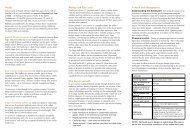Bushland Weeds Manual - Environmental Weeds Action Network
Bushland Weeds Manual - Environmental Weeds Action Network
Bushland Weeds Manual - Environmental Weeds Action Network
You also want an ePaper? Increase the reach of your titles
YUMPU automatically turns print PDFs into web optimized ePapers that Google loves.
Notes References<br />
Bio<br />
accumulation<br />
Average half-life<br />
in water<br />
Absorbed by Mode of action Average soil half-life Mobility in<br />
soil<br />
Basic properties Target weed<br />
species<br />
Poison<br />
schedule<br />
312, 305,<br />
119, 35,<br />
349, 226,<br />
247<br />
Toxic to most grasses except Vulpia<br />
spp and Poa annua . Toxic to fish.<br />
15 days low stable high potential<br />
in aquatic<br />
organisms<br />
foliage Inhibits acetyl-CoA<br />
carboxylase preventing the<br />
synthesis of lipids required<br />
for growth and maintenance<br />
of cell membranes.<br />
annual<br />
and perennial<br />
grasses<br />
S6 systemic,<br />
selective,<br />
non-residual,<br />
post- emergent<br />
Fluazifop-p-butyl<br />
(Fusilade 212 ® )<br />
Moderately toxic to aquatic species. 119, 61,<br />
247<br />
1 hour to 40 days<br />
(dependent on<br />
product)<br />
5-25 days lowmoderate<br />
Inhibits acetyl-CoA<br />
carboxylase preventing the<br />
synthesis of lipids required<br />
for growth and maintenance<br />
of cell membranes.<br />
foliage and<br />
roots<br />
some annual<br />
and perennial<br />
grasses<br />
Sethoxydim (Sertin Plus ® ) S5 systemic,<br />
selective,<br />
post- emergent,<br />
non-residual.<br />
Chapter 8 Herbicide Use in <strong>Bushland</strong><br />
Table 1. Properties of some herbicides used on bushland weeds.<br />
312, 204,<br />
119, 219,<br />
220<br />
47 days low 12 days to 10 weeks none known Little to no soil activity. In wetlands<br />
use special aquatic formulations.<br />
foliage Inhibits the shikimic acid<br />
pathway depleting aromatic<br />
amino acids required for<br />
protein construction.<br />
annual<br />
and perennial<br />
weeds<br />
S5 systemic,<br />
broad spectrum,<br />
non-residual,<br />
post- emergent<br />
Glyphosate (RoundUp ® ,<br />
RoundUp BiActive ® ,<br />
Glyphosate 360 ® & others)<br />
312, 106,<br />
119, 247<br />
<strong>Environmental</strong> persistence (up to 2<br />
years). Poses risk of groundwater<br />
contamination. Most grasses are<br />
resistant. Slight to moderate toxicity<br />
to fish and aquatic organisms.<br />
slight in fish,<br />
none recorded in<br />
milk or tissue of<br />
mammals<br />
1-40 days<br />
(depending on<br />
sunlight<br />
intensity)<br />
moderatehigh<br />
20 - 300 days<br />
(average 90 days)<br />
Auxin mimic - causes<br />
uncontrolled, disorganised<br />
growth.<br />
foliage and<br />
root uptake<br />
annual and<br />
perennial<br />
broadleaf<br />
weeds, vines,<br />
and woody<br />
plants<br />
S6 systemic,<br />
selective,<br />
residual<br />
Picloram + Triclopyr<br />
(Grazon DS ® or Access ® )<br />
119, 247,<br />
104<br />
little to none Commonly used herbicide. Low to<br />
non-toxic to birds, fish and bees.<br />
NOTE: The ester formulation is<br />
highly toxic to aquatic organisms.<br />
3 hours<br />
to 4 days<br />
moderatehigh<br />
30 - 90 days<br />
(average 46 days<br />
longer in cold or arid<br />
conditions)<br />
Auxin mimic - causes<br />
uncontrolled, disorganised<br />
growth.<br />
roots and<br />
foliage<br />
annual and<br />
perennial<br />
broadleaf<br />
weeds, vines,<br />
and woody<br />
plants<br />
Triclopyr (Garlon 600 ® ) S6 systemic,<br />
selective,<br />
non-residual,<br />
post-emergent<br />
110, 119,<br />
226<br />
21-30 days none known Biologically active at low rates.<br />
Persistence in soil varies according<br />
to soil pH, rainfall and soil type.<br />
Moderate to low toxicity to fish<br />
moderate -<br />
high (more<br />
mobile in<br />
alkaline<br />
conditions)<br />
14 - 180 days<br />
(average 60 days -<br />
more persistent in<br />
alkaline soils)<br />
Inhibits acetolactate<br />
synthase preventing cell<br />
division and thus growth.<br />
foliage and<br />
roots<br />
bulbs and<br />
broadleaf<br />
weeds<br />
unscheduled systemic,<br />
residual,<br />
post-emergent<br />
Metsulfuron methyl<br />
(Brush-off ® , Ally ® )<br />
111, 222,<br />
35<br />
Persistence varies according to<br />
soil pH, rainfall and soil type. Low<br />
toxicity to birds, mammals, fish and<br />
aquatic invertebrates.<br />
7-14 days does not<br />
accumulate in<br />
the milk or<br />
tissue of<br />
animals<br />
moderatehigh<br />
14 - 60 days<br />
(9 months in<br />
alkaline soils)<br />
Inhibits acetolactate<br />
synthase preventing cell<br />
division and thus growth.<br />
foliage and<br />
roots<br />
bulbs and<br />
broadleaf<br />
weeds<br />
Chlorsulfuron (Glean ® ) S5 systemic,<br />
residual,<br />
post-emergent<br />
105,169,<br />
312, 61<br />
8-40 days none known Low toxicity to mammals, birds,<br />
fish, aquatic invertebrates and bees.<br />
Soluble in water - potential for<br />
contamination.<br />
high<br />
potential<br />
12 days to 1 year<br />
(highest under<br />
anaerobic conditions and<br />
low microbial activity)<br />
Auxin mimic - causes<br />
uncontrolled, disorganised<br />
growth.<br />
foliage and<br />
some root<br />
absorption<br />
broadleaf<br />
weeds<br />
Clopyralid (Lontrel ® ) S5 systemic,<br />
selective,<br />
residual,<br />
post-emergent<br />
61, 119<br />
Low toxicity to birds, mammals,<br />
fish and molluscs. Moderate to high<br />
toxicity to shrimp and aquatic<br />
insects.<br />
does not<br />
accumulate in<br />
tissues (



